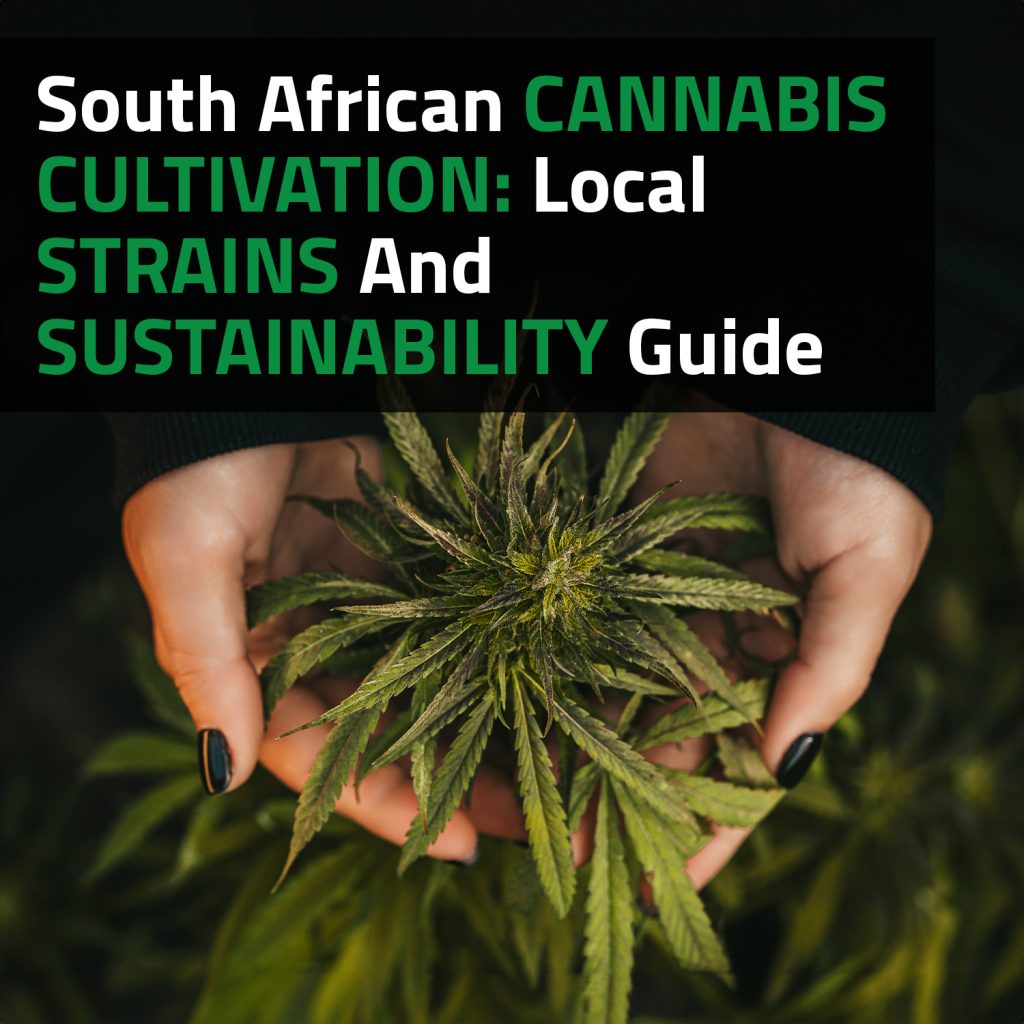South Africa’s unique climate and diverse landscapes offer an ideal setting for cannabis cultivation. With a rich history of indigenous strains and a growing interest in the therapeutic and recreational benefits of cannabis, many enthusiasts are eager to explore local strains and effective cultivation techniques.
South African Cannabis Strains
South Africa boasts a rich heritage of indigenous cannabis strains, each with its distinct characteristics and history. Some prominent local strains are worth exploring:
- Durban Poison
- Malawi Gold
- Ethiopian
- Apondo Mystic
Durban Poison
Durban Poison, another iconic South African strain, hails from the city of Durban on the country’s east coast. This sativa-dominant strain is famous for its sweet and spicy aroma, accompanied by invigorating, uplifting effects. Durban Poison’s energising properties have made it a global favourite, earning it a place among the world’s most sought-after sativas.
Malawi Gold
Malawi Gold is a legendary sativa strain that originates from the African nation of Malawi. It is one of Africa’s most famous and sought-after cannabis strains. Malawi Gold is known for its tall plants, long flowering period, and large, resinous buds. It typically offers a potent, uplifting, and energetic sativa high with a sweet, fruity flavour.
Ethiopian
The Ethiopian cannabis strain is named after its place of origin, Ethiopia. It’s known for being one of the oldest landrace strains in the world. Ethiopian strains are typically sativa-dominant, with tall plants, long internodal spacing, and a longer flowering period. They often produce an invigorating and cerebral high.
Apondo Mystic
Apondo Mystic is a less well-known strain, and its precise origins may not be as documented as others. It’s believed to have African roots, possibly from regions like Malawi or Swaziland. Specific characteristics of the Apondo Mystic strain can vary, but it’s generally associated with a balanced mix of sativa and indica effects. Its aroma and flavour profiles may also differ depending on the phenotype.
How Do South African Strains Compare To Global Varieties?
When comparing South African strains to their global counterparts, a few key factors come into play:
- Terpene Profiles and Aromas: South African strains often exhibit unique terpene profiles that contribute to their distinct aromas and flavours.
- Potency and Effects : While South African strains may not always boast the highest THC content, they are renowned for delivering a well-rounded experience.
Growing Techniques For South African Conditions
Cultivating cannabis in South Africa’s diverse climate requires a tailored approach. Whether you’re growing outdoors, in a greenhouse, or indoors, here are comprehensive insights into effective cultivation techniques.
Outdoor Cultivation
The advantages of growing cannabis outdoors are:
- Sunlight Abundance: South Africa’s sunny climate provides ample natural light, reducing energy costs.
- Large Yield Potential: Outdoor cultivation can yield substantial harvests when executed correctly.
- Natural Pest Control: Beneficial insects and predators thrive outdoors, aiding in pest management.
Best Practices for Outdoor Growing
- Choosing the Right Location: Consider local microclimates, sun exposure, and access to water sources.
- Soil Preparation and Amendments: Invest in nutrient-rich soil and organic amendments for healthy plant development.
- Timing and Seasonal Considerations: Understand the region’s seasons and plan planting accordingly to maximise growth.
Greenhouse Cultivation
Greenhouse cultivation in South Africa is tailored to adapt to the local climate in several ways.
- Temperature Control: Greenhouses offer climate regulation, ideal for sensitive strains.
- Light Management: Customise lighting to mimic natural sunlight and optimise growth.
- Pest and Disease Control: Isolation helps prevent pests and diseases from reaching plants.
Building and Maintaining a Cannabis Greenhouse
- Climate Control Systems: Install HVAC and ventilation systems to maintain ideal temperatures and humidity levels.
- Lighting Options and Strategies: Consider LED or HPS lighting and implement light schedules for different growth stages.
- Hydroponic vs. Soil-Based Systems: Choose a cultivation method that aligns with your greenhouse setup.
Indoor Cultivation
Indoor cultivation is a favourable choice for cannabis growers in South Africa due to several key advantages.
- Year-Round Cultivation: Indoor setups allow for cultivation regardless of external weather conditions.
- Precise Control: Control lighting, humidity, and temperature to optimise plant growth.
- Security and Discretion: Indoor cultivation offers enhanced privacy and security.
Setting Up an Indoor Cannabis Grow Room
- Lighting Options and Strategies: LED and HID lighting systems are popular choices, each with specific advantages.
- Ventilation and Air Quality: Install exhaust fans, carbon filters, and airflow systems for optimal conditions.
- Hydroponic vs. Soil-Based Systems: Select a cultivation method based on space, budget, and desired results.
Cannabis Cloning
Cannabis cloning is a technique employed by cultivators to replicate specific genetic characteristics from a parent cannabis plant, presenting a range of notable benefits.
- One primary advantage is the preservation of genetic consistency, as cloning guarantees that each newly propagated plant is an exact genetic replica of the parent, thus preserving the desired traits without any variation.
- This predictability in results enables growers to consistently reproduce exceptional strains, ensuring reliable and high-quality yields.
- Additionally, cloning significantly reduces the time needed for plant selection and growth, streamlining the cultivation process for increased efficiency and productivity.
The Cannabis Cloning Process
- Selecting the Mother Plant: Choose a healthy, mature cannabis plant with desirable traits as the source for cloning.
- Taking Cuttings: Carefully cut sections of the mother plant’s stem, typically from the lower branches.
- Rooting Medium: Place the cuttings in a rooting medium, such as rockwool cubes or peat pellets, to encourage root development.
- Rooting Hormone: Dip the cut end of each cutting in rooting hormone to stimulate root growth.
- Maintaining Ideal Conditions: Provide a stable environment with high humidity and moderate light for the cuttings to root successfully.
- Transplanting: Once roots have developed, transplant the rooted cuttings into soil or your chosen growing medium.
Cannabis cloning is a valuable technique for preserving and propagating exceptional strains in South Africa’s diverse cannabis cultivation landscape.
Legal Considerations
Cannabis cultivation in South Africa is subject to specific laws and regulations. Understanding the legal landscape is essential for both seasoned cultivators and newcomers to the industry.
What Are the Current Cannabis Laws In South Africa?
South Africa’s cannabis laws have evolved over the years, and as of the latest updates, they fall under two main categories: decriminalisation and legalisation.
Decriminalisation Vs. Legalisation
In South Africa, the private use and possession of cannabis have been decriminalised to some extent. This means that the consumption of cannabis in private spaces is no longer subject to criminal prosecution. However, selling or supplying cannabis remains illegal.
While cannabis has been decriminalised for personal use, full legalisation for recreational purposes is still under consideration by the government. The Cannabis for Private Purposes Bill has been in discussion, and it aims to regulate the private cultivation, possession, and use of cannabis.
As the legal landscape evolves, it’s crucial to be aware of the licensing and regulatory bodies responsible for overseeing cannabis-related activities. Licensing may be required for various aspects of the cannabis industry, including cultivation, distribution, and retail.
How Does Compliance With Cannabis Laws Impact Cultivation?
Compliance with cannabis laws is essential for cultivators to operate legally and avoid potential legal consequences. Understanding how these laws impact cultivation is vital.
Limits On Plant Numbers And Possession
Depending on the specific regulations in your region, there may be limits on the number of cannabis plants you can cultivate for personal use. Be sure to research and adhere to these limits. Laws also typically specify the maximum amount of cannabis that an individual can possess. This includes both dried flower and cannabis products.
Reporting And Record-Keeping Requirements
Cultivators are often required to maintain detailed records of their activities, including:
- Cultivation Records: Keep records of plant counts, growth stages, and any fertilisers or pesticides used.
- Harvest Records: Document harvest dates, yields, and any processing or drying techniques employed.
- Compliance Reports: Submit any required reports to regulatory authorities, detailing adherence to local cannabis laws.
Maintaining accurate records not only ensures compliance but also assists in quality control and provides a history of your cultivation process.
Harvesting And Processing
Cannabis cultivation is a labour of love, and the timing of your harvest can significantly impact the quality and potency of your crop. In this section, we explore when to harvest cannabis in South Africa and the essential post-harvest processes.
When Is The Ideal Time To Harvest Cannabis In South Africa?
Harvesting cannabis at the right moment is crucial to achieving the desired effects and maximising the plant’s potential. Different strains and cultivation methods may require varying harvest times.
Recognising Signs Of Maturity
One of the most reliable indicators of maturity is the appearance of trichomes. When trichomes turn milky or amber (from their initial clear state), it’s a sign that the plant is ready for harvest. Observe the pistils (hairs) on the flowers. Most strains are ready when a significant portion of the pistils changes from white to a reddish-brown or amber colour. As the flowers mature, the calyxes (the small, protective structures surrounding the bud) will swell, making them plump and dense.
Considerations For Different Strains
Different strains have unique growth patterns and maturation rates. Consider the following strain-specific factors:
- Indica vs. Sativa: Indica strains often mature more quickly than sativa strains. Sativas may require an extra week or two to reach their peak.
- Autoflowering Varieties: Autoflowering strains have a predetermined flowering period, making timing more predictable.
Post-Harvest Handling And Processing
Once you’ve carefully selected the optimal harvest time, the next crucial steps involve post-harvest handling and processing to preserve the quality of your cannabis.
Drying And Curing Techniques
- Drying: Hang harvested cannabis branches in a cool, dark, and well-ventilated space. Maintain a consistent temperature and humidity level to avoid mould and mildew. Drying typically takes 5-15 days, depending on environmental conditions.
- Curing: After drying, place the buds in airtight containers (such as glass jars). Burp the containers daily for the first two weeks to release excess moisture and prevent mould. Proper curing can enhance flavour, aroma, and potency and should last for at least two weeks, though many growers prefer a longer cure.
Extraction And Concentrate Production
For those interested in further processing cannabis into concentrates or extracts, it’s essential to understand the methods and safety precautions involved.
- Solvent-Based Extraction: Techniques like butane or ethanol extraction can produce highly potent concentrates. Ensure proper ventilation and safety measures to avoid accidents.
- Solventless Extraction: Methods like rosin pressing and ice water hash offer solvent-free alternatives for making concentrates.
- Safety First: Always follow safety guidelines when working with solvents or heat, and store concentrates securely away from children and pets.
Proper harvesting, drying, curing, and processing techniques are crucial to maintaining the quality and potency of your South African cannabis crop. By paying close attention to these steps, you can enjoy the full potential of your harvest.
Challenges And Sustainability
Cultivating cannabis in South Africa, like any agricultural endeavour, comes with its own set of challenges. In this section, we’ll explore the common challenges faced by South African cannabis growers and discuss strategies for promoting sustainable cultivation practices.
What Are The Common Challenges Faced By South African Cannabis Growers?
Cannabis cultivation in South Africa is a rewarding but challenging pursuit. Here are some of the common hurdles faced by growers in the region:
- Climate-Related Issues:South Africa’s climates vary greatly, from arid regions to temperate coastal areas. Growers must adapt their cultivation techniques to suit local conditions. Water availability can be a significant challenge, especially in regions prone to drought. Sustainable water management practices are crucial.
- Security Concerns: Cannabis cultivation can be an attractive target for theft or vandalism. Adequate security measures are essential to protect crops and facilities. Despite changing laws, the legal status of cannabis can still lead to security issues. Ensuring compliance with local regulations is vital.
Promoting Sustainable Cannabis Cultivation In South Africa
Sustainability is not only essential for preserving the environment but also for ensuring the long-term success of the cannabis industry in South Africa. Here are some strategies to promote sustainable cultivation:
- Water Conservation: Implement water-saving techniques like drip irrigation and rainwater harvesting to minimise water usage.
- Organic Farming: Choose organic and eco-friendly fertilisers and pesticides to reduce the environmental impact.
- Energy Efficiency: Utilise energy-efficient lighting and ventilation systems in indoor cultivation to reduce energy consumption.
Community Engagement And Empowerment
Foster community awareness of responsible cannabis cultivation, highlighting its advantages and potential economic prospects. Generate employment locally, effectively reducing unemployment and fostering economic growth. Champion environmental conservation initiatives like reforestation and wildlife habitat restoration to mitigate the environmental footprint of cultivation.
By addressing the challenges and embracing sustainable practices, South African cannabis growers can not only produce high-quality crops but also contribute positively to their communities and the environment.
In conclusion, South African cannabis cultivation presents a dynamic blend of indigenous strains and sustainable practices. As the nation continues to navigate its evolving legal landscape and address unique challenges, the future of cannabis in the Rainbow Nation holds promising opportunities for growers and communities alike. Embracing local strains and sustainable cultivation methods is not only a path to success but also a step towards a greener and more vibrant cannabis industry in South Africa.










